Fantastic (Four)ays: Fantastic Four #3 Review
A simple villain is overshadowed by a hearty cliffhanger and classic artistic contributions to the ever-evolving FF mythos
—by Nathan on July 13, 2025—
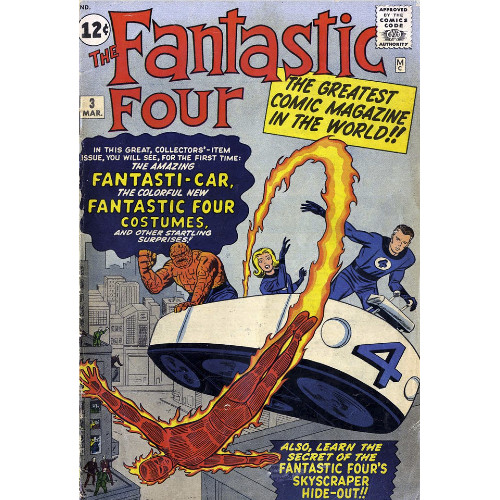
Being famous has its perks, I suppose.
If you're Reed Richards of the Fantastic Four, you've made sure your best friends have a pretty good life, the whole "getting doused by cosmic rays and having your physical forms changed irrevocably one way or another" bit notwithstanding. Sure, people knowing your faces and names backfires every so often, like that time the Skrulls impersonated you and your teammates, but think of all of the benefits: you have a sweet penthouse headquarters, complete with private elevator, pogo plane, and living area; you get some snazzy costumes (even if a certain rockhead refuses to wear the helmet) and a cool "flying car" (even if some people will never stop calling it a "bathtub"); and you have won the adoration and love of the general public.
If you're Reed Richards, or Susan Storm, or her brother Johnny, or Ben Grimm, you're in the public spotlight…literally, as the team comes to find one night while attending a magic show. The magician performing this evening, the Miracle Man (not to be confused with "Miracleman"), calls attention to the team…but not just to recognize their contributions to humanity. No, he has a less-than-altruistic motivation in mind. He wants to humiliate the Four, show how his power rivals theirs…and, if his little demonstration proves anything, it could be that the FF have encountered a man who, as Reed claims, "might be the one foe we could not defeat!"
"The Menace of the Miracle Man"
Writer: Stan Lee
Penciler: Jack Kirby
Inkers: Sol Brodsky
Colorist: Stan Goldberg
Letterers: Artie Simek
Issue: Fantastic Four #3
Issue Publication Date: March 1962
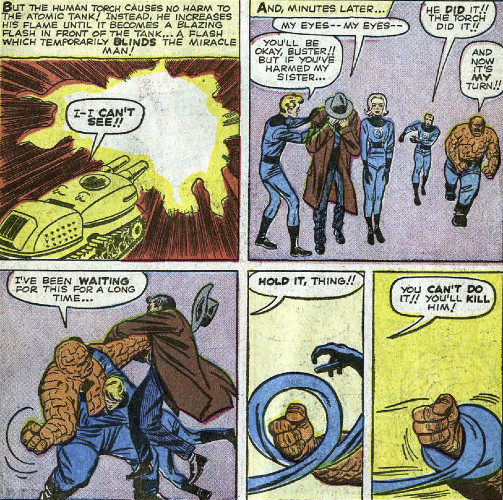
You will, perhaps, be willing to forgive Reed his predilection for exaggeration. After all, it isn't like the FF have faced many foes as of yet–a few subterranean monsters and some shape-shifting aliens–but you also wouldn't think a stage magician performing seemingly miraculous feats would concern him nearly as much. Maybe chalk it up to his handlers, Lee and Kirby, hyping themselves for what is to unfold in this third issue of their superhero drama.
Lee and Kirby's run on Fantastic Four is considered one of the greatest comic runs ever put to paper, and this issue is where I feel we begin to see the pieces come together. Like a magician performing a feat, Lee and Kirby know all the moves necessary to enthrall the audience and build towards that fateful "ta-da!" moment…not trick them, no, but engage their imagination. The FF's first two appearances, entertaining as they are, felt like Lee and Kirby testing the waters, feeling for what clicked with audiences, forming the foundations. Here, they begin construction of a time-tested run by fully cementing the elements which fans will continue devouring for decades.
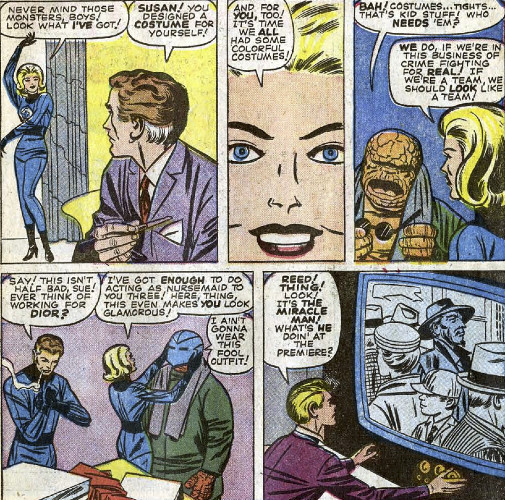
The previous two issues had established the family dynamic already–Reed's father-like manner, Ben and Johnny's squabbling, Sue's matronly affectations–but this issue pulls out all the stops. In one well-structured scene, Ben takes a swing at Johnny when the flame-brained teenager riles him up in response to Ben's own moody demeanor, which is generated by what Ben believes is misplaced encouragement from Reed. The three men exist in a difficult dynamic, with Johnny's hot-headed humor always popping up at the incorrect time, Ben's rage overriding any logic or understanding, and Reed's scientific mind struggling to connect with his friend on an emotional level. "Why can't you control yourself, Thing?" he asks Ben bluntly. "Why must we always fight among ourselves? What's wrong with us?" Though Ben responds curtly ("All I gotta do is look in the mirror to answer that one, brother!"), Reed's use of "Thing" almost provides his own answer: they're different, they'll be different forever, and it's something Reed treats as a fact that Ben desperately wishes not to and Johnny treats with less respect than deserved.
There is the implication, subtle enough for me to call this conjecture on my part, that the bickering between the three is enhanced by Sue not being present. Serving as the team's "mother" and a calming presence, Sue has pursued the Miracle Man when this confrontation occurs. Though taken hostage shortly thereafter, Sue is offered her own agency outside the men of the group, taking it upon herself to follow after the so-called magician. I do wish she had accomplished her mission successfully, though her capture is intended to create more tension and lead into a final confrontation between the Miracle Man and the Fantastic Four.
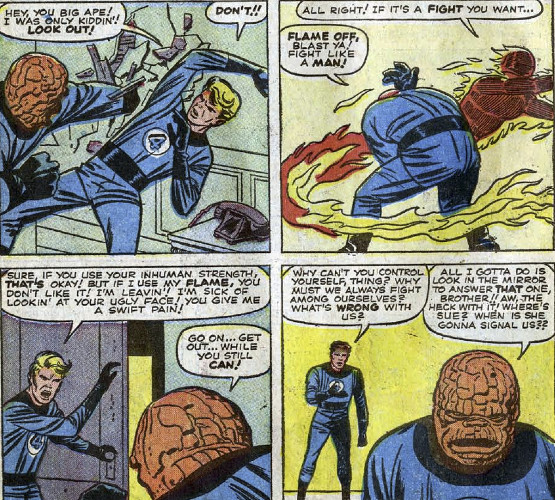
Elsewhere, Sue's other contribution, the FF's uniforms, introduces us to some of the most iconic outfits in the entirety of comics. For the past two issues, the FF had engaged their enemies in their "civvies," and though I believed these regular clothes gave the team a bit more grounding than other superheroes, the introduction of the classic uniforms is a necessity which works wonderfully well here. The shared design between the outfits–which, for the briefest of spaces, even Ben uses–creates uniformity between the team. Though it's simple in nature, blue with black boots, gloves, and the "4" emblem, the style is effective. The blue is a welcome splash of color which draws the eye, and the emblem is the perfect symbol for the team as a whole. Yes, the uniforms have been redesigned at times over the decades, but the nature of the original costumes has remained fairly intact. Simple, effective, eye-catching. They're perfect and represent a significant development in the lives and careers of these characters…even if Ben has no fondness for the "monkey suit" or the helmet Sue makes for him.
The headquarters and Fantasticar are other significant developments within the issue, serving as not only two classic FF elements which will be maintained throughout the team's history but also as practical elements to their work as superheroes. I don't necessarily believe Lee and Kirby gave the team a headquarters and vehicles because they intended them to be immediately iconic, but I can see them creating a viable method of transportation and a place the FF can call home. It's a fact: superheroes have headquarters! Superman has his Fortress of Solitude, Batman has his Batcave, Spider-Man has his, uh, bedroom in his Aunt May's Forest Hills home…and the FF have the Baxter Building! Though not named as such here, the Baxter Building is a central place where the team can work and thrive. And the ever-inventive Kirby should be applauded for designing a Fantasticar which imaginatively splits into four sections, allowing each of the FF the ability to cover more ground in their search for the Miracle Man, even if you spend a second or two puzzled as to why the Human Torch needs his own section of a flying bathtub.
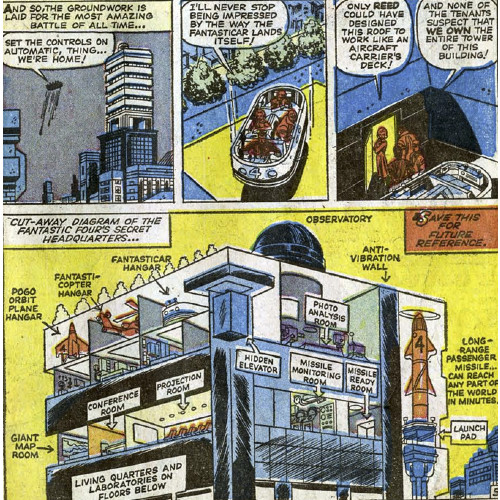
The Miracle Man himself has never risen the ranks as one of the FF's most feared foes, though he does inadvertently lead to the temporary dissolution of the Four by this issue's end with the departure of one slighted Johnny Storm. He's a con artist, a trickster, his so-called powers relying on hypnotism, as Lee and Kirby reveal at the end of this piece. Maybe that explains Reed's earlier hyperbole, convinced by the madman's hypnotic trance as to his menace. The Miracle Man is a one-trick kind of bad guy, someone you wouldn't anticipate being recycled often once his primary gimmick is exposed. He's a poor man's Mysterio, without even a backstory to allow the possibility of empathy. He's got some nifty tricks–a marquee monster model seemingly comes to life to menace the FF, and he humiliates the ever-lovin' blue-eyed Thing early in the issue–but he's not nearly as threatening as he hopes to be. Heck, his most villainous action, if you discount hypnotizing our heroes, is clubbing Mr. Fantastic over the head with a brick–no magic necessary, just good old-fashioned brute force.
Since I referenced it in the last paragraph, I should note I appreciate how this issue ends, with flame-tempered Jonathan Spencer (yes, his real middle name) Storm, uh, storming off, leaving his three teammates to ponder his fate…and theirs. Goaded by the Thing's consistent belligerent attitude towards him, the Torch soars into the night sky, unwilling to listen to his sister's pleas. It's a strong moment, ending the issue on a surprising cliffhanger. The nature of the cliffhanger itself is a surprise–the Four aren't left to the mercies of a supervillain but their own internal struggles–but that Lee and Kirby use these final panels to throw the team's future into chaos at the end of only their third issue is a genuine surprise as well. We're not left with the standard emotional high of our heroes defeating a supervillain; we're left unaware as to what the next issue will hold.
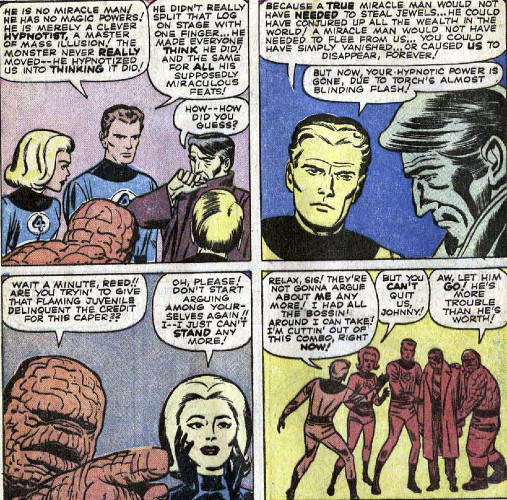
(though Reed, embellishing again, notes they should worry for humanity if Johnny's fate takes a darker turn: "What will we do–what can we do, if…if he should turn against us?!!!" Geez, Reed, not every potential threat can possibly become the one menace you guys can't defeat…and you call yourself "Mr. Fantastic"!)
Reed's penchant for flamboyant figurative expressiveness aside, Lee and Kirby cook up a doozy of an issue for readers. The pieces feel like they've fallen appropriately into place. New elements will pop up further down the line–especially, as we shall see, the emergence of classic arch-enemies–but fans are welcomed to embrace the core elements which will define these heroes: the costumes, the headquarters, the verbal sniping. If you quickly grow to love this stuff, good for you. Unlike the Human Torch at issue's end, these elements ain't going anywhere.